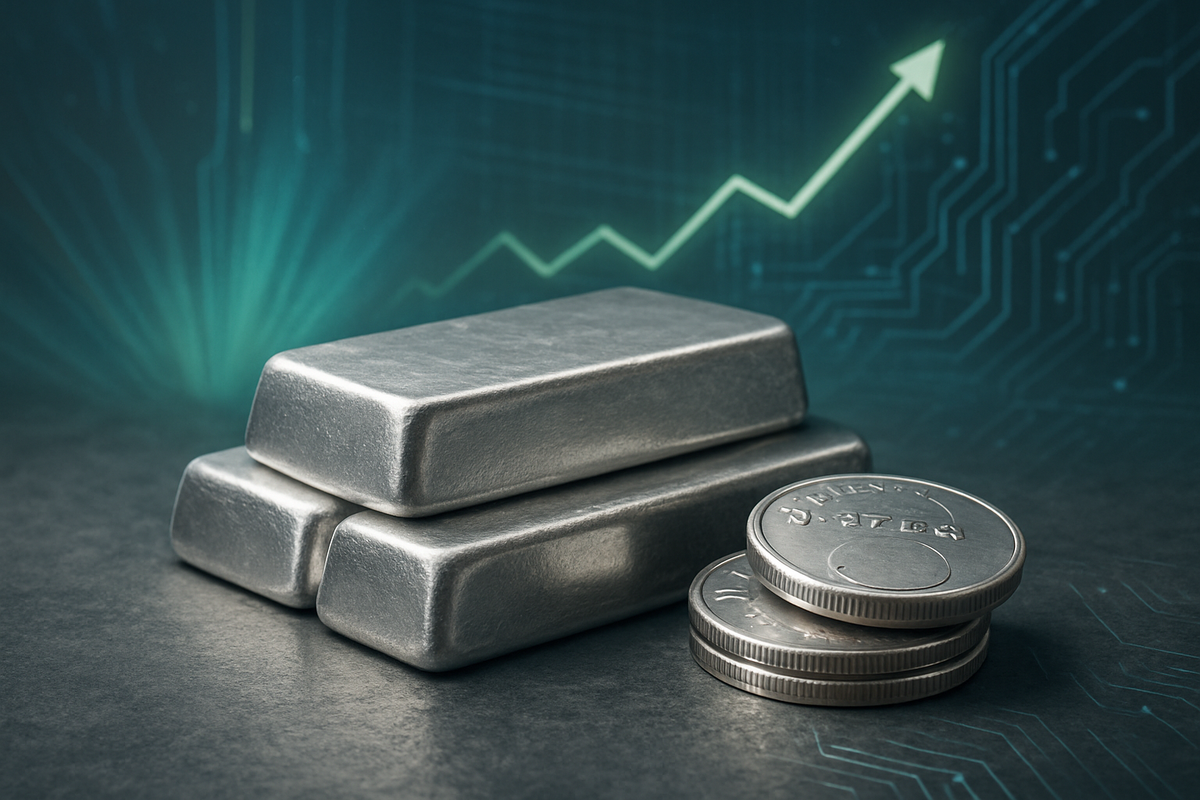
Silver (XAG/USD) has demonstrated remarkable resilience, successfully stabilizing above its crucial 50-day Simple Moving Average (SMA) following a sharp 16% correction that had rattled the precious metals market. This pivotal technical rebound, occurring after a significant dip from its October 2025 highs, is now fostering a cautiously optimistic market sentiment, suggesting that the white metal may be poised for a renewed upward trajectory. The ability of silver to hold this key support level signals a potential turning point, inviting "buy the dip" behavior and reinforcing its long-term bullish outlook amidst evolving macroeconomic conditions.
The stabilization is particularly significant given the preceding volatility. After reaching an impressive peak of approximately $54.42-$54.86 in October 2025, silver experienced a rapid descent, plummeting to a five-week low near $45.56-$45.57. This sharp correction, driven by a confluence of factors including profit-taking and shifting market dynamics, saw the precious metal shed 16% of its value in a relatively short period. However, the 50-day SMA, identified as a critical technical support level within the $45.21 to $44.80 range, proved to be an impenetrable barrier, preventing a deeper decline and setting the stage for the current recovery.
Navigating the Correction: Technical Resilience and Market Reaffirmation
The journey to silver's current resilient stance was marked by a period of intense selling pressure. From its October 2025 zenith, the market witnessed a substantial unwinding of long positions as investors took profits, leading to the sharp 16% correction. This rapid decline pushed XAG/USD into oversold territory, a condition often preceding a reversal. The subsequent stabilization above the 50-day SMA was not merely a random event but a clear technical affirmation, indicating that the selling pressure had largely exhausted itself and that buyers were stepping in decisively at this critical juncture.
The timeline of events highlights the significance of this rebound. After peaking in October, silver's price action became increasingly bearish, culminating in the five-week low. However, the emergence of a bullish doji candlestick pattern near the 50-day Exponential Moving Average (EMA) served as an early warning signal of a potential trend reversal, indicating indecision that ultimately favored the bulls. This technical formation, combined with the steadfast defense of the 50-day SMA, has emboldened market participants. Initial market reactions have been characterized by renewed interest from institutional and retail investors looking to capitalize on what they perceive as an attractive entry point, especially with the longer-term trend remaining firmly bullish above both the 50-day and 200-day SMAs.
Key technical indicators are now flashing green for silver. As long as XAG/USD maintains its footing above the 50-day SMA, the technical picture generally favors further gains. Analysts are now eyeing a rally towards the $50.02–$51.07 range. Immediate resistance levels at $48.00, $48.45-$48.50, and particularly the $49.00-$49.50 zone (which includes the 21-day SMA), will be crucial hurdles to overcome. A sustained breach of these levels could trigger the next significant leg of an upward trajectory, signaling a robust recovery from the recent correction. Conversely, a decisive move below the 50-day moving average would dampen bullish sentiment, potentially leading to profit-taking and a retest of the $45.00 psychological mark or even $44.45.
Corporate Fortunes Tied to Silver's Trajectory
The renewed strength in silver prices could significantly impact public companies with substantial exposure to the precious metal, ranging from mining operations to investment vehicles. Silver's dual role as an industrial metal and a safe-haven asset means its price movements have broad implications across several sectors. Companies involved in silver extraction stand to be primary beneficiaries, while those relying on silver as an industrial input might face increased costs, though this is often offset by broader economic conditions that favor higher commodity prices.
Mining giants such as Fresnillo PLC (LSE: FRES), Pan American Silver Corp. (NASDAQ: PAAS), and Wheaton Precious Metals Corp. (NYSE: WPM) are particularly sensitive to silver price fluctuations. A sustained upward trend in XAG/USD would directly translate into higher revenues and potentially fatter profit margins for these companies. Fresnillo, a major silver producer, would see its core business strengthened, allowing for increased exploration budgets and potential dividend increases. Pan American Silver, with its diverse portfolio of mines across the Americas, would experience a boost in its operational profitability. Similarly, Wheaton Precious Metals, a streaming and royalty company, would benefit from higher realized silver prices on its existing contracts, enhancing its cash flow and valuation. Conversely, a reversal in silver's fortunes, though less likely in the immediate term given the current technical support, would exert downward pressure on their stock prices and financial performance.
Beyond direct miners, companies involved in silver-backed Exchange Traded Funds (ETFs) and those utilizing silver in high-tech industrial applications also stand to gain. For instance, the iShares Silver Trust (NYSEARCA: SLV), a popular ETF that tracks the price of silver, would see its net asset value increase, attracting more investor capital. Furthermore, companies in the solar energy sector, such as First Solar, Inc. (NASDAQ: FSLR), and electric vehicle manufacturers, like Tesla, Inc. (NASDAQ: TSLA), which use silver in their components, might face marginally higher input costs. However, the broader narrative of a strengthening commodity market often coincides with robust economic growth and increased demand for these green technologies, potentially offsetting the cost increases with higher sales volumes. The expanding demand from AI data centers, which also utilize silver, adds another layer of industrial demand that supports the metal's long-term price outlook, benefiting companies across this technological supply chain.
Broader Implications: A Barometer for Economic Shifts
Silver's recent resilience and stabilization extend beyond mere technical charts, offering a valuable barometer for broader industry trends and economic shifts. Its performance often mirrors the health of the industrial sector due to its extensive use in electronics, solar panels, and medical devices, while simultaneously acting as a safe-haven asset during times of economic uncertainty. This dual nature positions silver as a unique indicator, reflecting both growth prospects and risk aversion in the global economy.
The current stabilization of silver prices fits into a broader trend of strengthening commodity markets, fueled by persistent supply deficits and burgeoning demand from the green economy and technological advancements. The increasing global push towards renewable energy, particularly solar power, is a significant driver of industrial silver demand. As countries commit to decarbonization, the production of solar photovoltaic cells, which heavily rely on silver paste, is set to surge. Similarly, the rapid expansion of electric vehicles (EVs) and the construction of new AI data centers are creating additional, robust demand for silver, cementing its role as a critical material for future technologies. These structural demand shifts provide a strong fundamental underpin for silver prices, suggesting that the recent correction was more of a technical adjustment than a fundamental weakening.
Potential ripple effects from silver's upward momentum could be felt across the broader precious metals complex, potentially lifting gold and platinum. Historically, silver often outperforms gold during periods of strong economic growth and rising inflation expectations, given its higher industrial leverage. This could lead to a narrowing of the gold-silver ratio, a key indicator for precious metals investors. Regulatory or policy implications, particularly those related to environmental initiatives and infrastructure spending, could further bolster silver's demand profile. Government incentives for renewable energy and EV adoption directly translate into increased silver consumption. Looking back, historical precedents show that corrections followed by strong technical rebounds, especially above key moving averages, often precede significant bull runs, reinforcing the current optimistic outlook. For example, similar patterns were observed during the commodity booms of the early 2000s, where strong industrial demand combined with loose monetary policy propelled silver prices significantly higher.
The Road Ahead: Opportunities and Challenges
Looking ahead, silver's ability to maintain its current trajectory will hinge on a delicate balance of macroeconomic factors, technical indicators, and evolving market sentiment. In the short term, the focus remains on silver's steadfast hold above the 50-day SMA. A sustained consolidation above this level could pave the way for a retest of the October 2025 highs, potentially pushing XAG/USD towards the $50-$51 range. Traders will be keenly watching for a decisive breach of immediate resistance levels, which could signal the initiation of the next significant upward leg.
In the long term, the outlook for silver remains robust, underpinned by strong fundamental drivers. The increasing industrial demand from the burgeoning green economy, including solar power and electric vehicles, coupled with the expansion of AI data centers, provides a structural tailwind for the metal. Persistent supply deficits, exacerbated by underinvestment in new mining projects, are also expected to keep the market tight, supporting higher prices. These factors suggest that silver is well-positioned for continued appreciation over the coming months and years, making it an attractive asset for long-term investors seeking exposure to both industrial growth and inflation hedges.
However, potential challenges and market opportunities will undoubtedly emerge. While a dovish Federal Reserve stance, characterized by further rate cuts, could significantly fuel silver's upside by weakening the U.S. dollar and reducing the opportunity cost of holding non-yielding assets, a more hawkish tone or unexpected shifts in monetary policy could cap rallies. Improved global risk sentiment, stemming from geopolitical stability or robust economic data, might also dampen safe-haven demand for silver, although its industrial demand would likely remain strong. Investors should also monitor inflation data and global manufacturing indices, as these will provide crucial insights into the health of the industrial sector and the broader economic environment that influences silver prices. Strategic pivots or adaptations required by mining companies might include accelerating exploration efforts or optimizing production to capitalize on higher prices, while industrial users might explore alternative materials if silver prices become prohibitively expensive, though its unique properties often make substitution difficult.
Charting the Course: A Resilient Future for Silver
Silver's recent stabilization above the 50-day Simple Moving Average after a sharp 16% correction marks a significant turning point, underscoring the metal's inherent resilience and the underlying strength of its fundamental drivers. This technical rebound, combined with cautiously optimistic market sentiment, suggests that the corrective phase may have largely run its course, setting the stage for potential further gains. The ability of XAG/USD to defend this critical support level reinforces the long-term bullish outlook for silver, positioning it as a compelling asset in the current economic landscape.
Moving forward, the market will closely monitor silver's capacity to consolidate above the 50-day SMA and overcome immediate resistance levels. The interplay between a potentially dovish Federal Reserve, persistent industrial demand from the green economy and AI sectors, and ongoing supply deficits will be crucial in shaping silver's trajectory. Companies in the silver mining sector, such as Fresnillo PLC (LSE: FRES), Pan American Silver Corp. (NASDAQ: PAAS), and Wheaton Precious Metals Corp. (NYSE: WPM), stand to benefit significantly from a sustained rally, while investors in instruments like the iShares Silver Trust (NYSEARCA: SLV) could see their portfolios appreciate.
Investors should watch for key macroeconomic indicators, particularly inflation data and Federal Reserve communications, as these will provide vital clues regarding future monetary policy and its impact on precious metals. The continued expansion of renewable energy infrastructure and technological advancements will also be critical drivers of industrial demand, offering a robust floor for silver prices. While short-term volatility is always a possibility, the current technical setup and strong fundamental backdrop paint a picture of a resilient silver market poised for a potentially brighter future.
This content is intended for informational purposes only and is not financial advice






